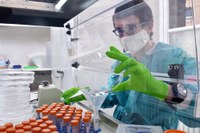Rotifers back in space again: a new journey from Namur to ISS!
Exactly one year ago, the UNamur and Belgian Nuclear Research Centre (SCK-CEN) launched together a unique experiment at the International Space Station (ISS) in the framework of the Rotifer in Space (RISE) project. Bdelloid rotifers are microscopic animals known to be extremely stress tolerant and to reproduce asexually by cloning themselves. Rotifers can survive desiccation at any life stage, which confers them tolerance to a variety of stresses including high doses of radiation. During the first mission in December 2019, Bdelloid rotifers Adineta vaga stayed in orbit for two weeks, in order to explore their resistance to microgravity and cosmic radiation. Upon returning to the UNamur, scientists observed that weightlessness did not affect their survival and fertility. Gene expression analyses are still ongoing to further investigate the effects of space travel on this micro-organism.
One year later, it is a second spatial experiment that has being launched by the RISE team. Rotifers successfully reached ISS on December 6th 2020 aboard a Falcon 9 Space X rocket. But this time, Bdelloid rotifers Adineta vaga were submitted to desiccation and 500 Gy X-ray or proton radiation inducing double-strand DNA breaks before flying to space. The goal is now to evaluate whether space environment has an impact on DNA repair processes of living organisms. Therefore, the capacity of A. vaga to repair their broken genome will be compared in space and on earth. The first step of desiccation of 1.800.000 A. vaga individuals was performed in the LEGE laboratory of the UNamur, while irradiation took place at the LARN laboratory. Dried and irradiated A. vaga individuals were then integrated in flight modules and send to Kennedy Space Center in Florida (USA) to fly with the SpaceX CRS-21, a Commercial Resupply Service mission, to ISS.
This research program should bring important knowledge that will help to better protect astronauts against damaging effects of weightlessness and high doses of cosmic radiation. Moreover, these findings may also have an interest on earth, for example to improve protection of professionally exposed people or to preserve cancer patients from the negative side effects of radiation therapy.
The RISE team:
UNamur, LEGE laboratory, ILEE-NARILIS
Prof. Karine Van Doninck, Dr. Boris Hespeels (postdoc), Victoria Moris (postdoc), Jérémy Berthe (lab technician) and Lucie Bruneau (lab technician)
UNamur, LARN laboratory, NARILIS:
Prof. Stéphane Lucas, Prof. Anne-Catherine Heuskin, Dr. Sébastien Penninckx (postdoc), Richard Coos (engineer), Margot Cardinal (lab technician)
SCK CEN, Radiobiology Unit:
Prof. Sarah Baatout and Dr. Bjorn Baselet
Picture by Marc Guillaume
 NAmur Research Institute for LIfe Sciences
NAmur Research Institute for LIfe Sciences


